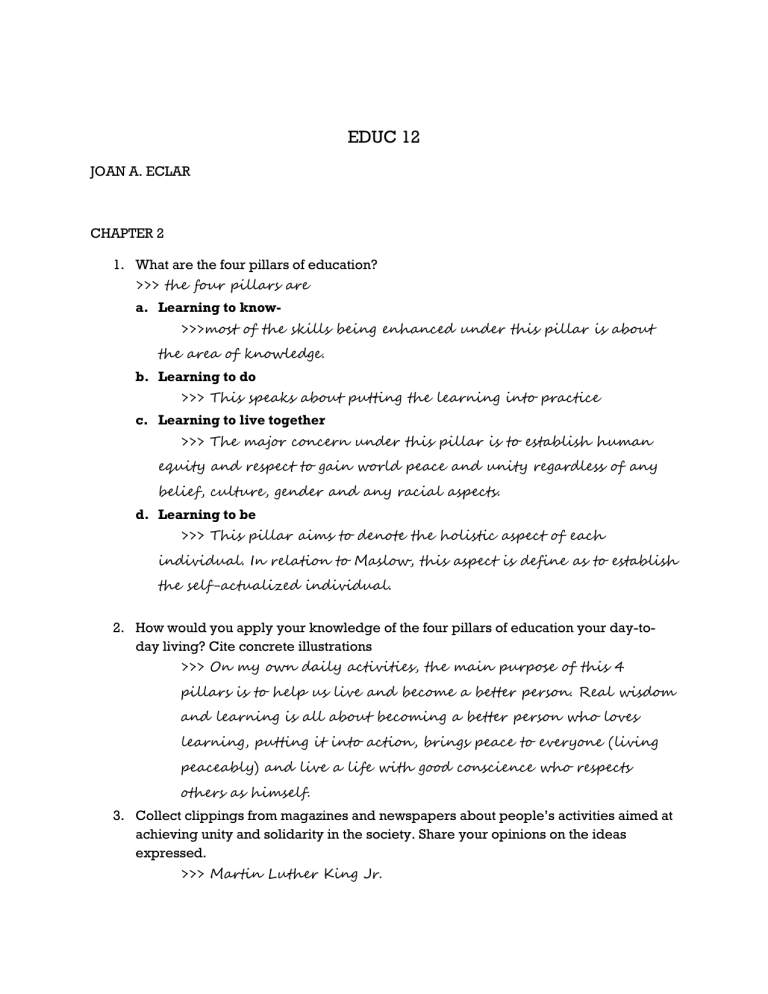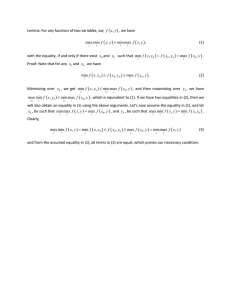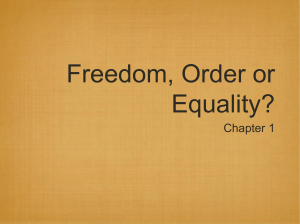
EDUC 12
JOAN A. ECLAR
CHAPTER 2
1.
What are the four pillars of education?
>>> the four pillars are a.
Learning to know-
>>>most of the skills being enhanced under this pillar is about the area of knowledge. b.
Learning to do
>>> This speaks about putting the learning into practice c.
Learning to live together
>>> The major concern under this pillar is to establish human equity and respect to gain world peace and unity regardless of any belief, culture, gender and any racial aspects. d.
Learning to be
>>> This pillar aims to denote the holistic aspect of each individual. In relation to Maslow, this aspect is define as to establish the self-actualized individual.
2.
How would you apply your knowledge of the four pillars of education your day-today living? Cite concrete illustrations
>>> On my own daily activities, the main purpose of this 4 pillars is to help us live and become a better person. Real wisdom and learning is all about becoming a better person who loves learning, putting it into action, brings peace to everyone (living peaceably) and live a life with good conscience who respects others as himself.
3.
Collect clippings from magazines and newspapers about people’s activities aimed at achieving unity and solidarity in the society. Share your opinions on the ideas expressed.
>>> Martin Luther King Jr.
CHAPTER 3
1.
Interaction on the certain topics, a.
The importance of intercultural communication
>>> It is important to communicate to other countries, regions and to ethnic groups because it helps us to understand their way of living and culture. Because of that we could established peace with them and could also make business with them and vice versa. b.
The significance of understanding culture, its elements, characteristics and components.
>>> The establishment of peace and good communication that could probably lead to strong unification which gives emphasis to equality and respect of humankind.
2.
Observe your classmates and describe how they differ from each other in the way they talk, act and behave.
>>> Everyone has its own uniqueness; one talk slowly, other is loud, while the other one is quiet.
3.
List down situations to show the significance of man’s language in his daily activities.
>>> a.
Giving command b.
Expressing the feelings c.
Voicing instructions d.
Talking to love ones e.
Giving details
CHAPTER 4
1.
Why is there a need for peace education?
>>> It is really indeed a need of peace education for it promotes equality and ability to transform negativity to positivity and gives us awareness and understanding of every individual.
2.
In what way is peace education practical and ethical?
>>> By promoting anti-violence and considering the negation of life and well being which gives values to obtain unity and common good.
3.
Describe a peace educator and a peaceable classroom. List down the attributes of each.
>>> As educators, they should be a model of personal transformation and promote peace within self that manifests to outer aura. a.
Educators should be a responsible global citizen who believes in global equality who encourages learners to be socially equal in discussion and interactions. b.
S/he should always be involved and attached to the peer society so that s/he should always have it share in the community. c.
Perspective-taking d.
Problem-solvers
CHAPTER 5
1.
Explain cultural change and its effects on the life of the people.
>>> Cultural change is adaptation of one culture to another; it can innovate, develop or degrade the first culture. Sometimes, the acceptance of another culture can be individual, regional, familial, racial or national.
2.
What is subculture? Is it advantageous to the progress of a society?
>>> Subculture refers to cultural patterns that set apart some segment of a society’s population. It can be based on age, ethnicity, residence,
sexual preference, occupation or any other factor (in short, GROUP). For me it is advantageous because subculture only deals to define groups for some purposes and goal but does not really create divisions to the whole society.
3.
How can teachers meet the diverse needs of an increasingly multicultural student population?
>>> Teachers must be aware of student’s subcultures and understand it so that they could easily linger and can adapt and the students could also adapt to their instructions and meet their diverse learning needs.
CHAPTER 6
1.
Enumerate and explain the basic functions of each social institution.
>>> a.
THE FAMILY- ensures early values and behaviours through interaction with other members. b.
EDUCATION- secures the transmission of knowledge, to gain and develop. c.
RELIGION- establishes beliefs and morals concerning the ultimate meaning of life; and assumes the existence of the supernatural to be of reality and the truth. d.
ECONOMIC INTITUTIONS- it provides views of better management and balance of resources, goods, services and products. e.
GOVERNMENT AS A SOCIAL INSTITUTIONS- to maintain a good social order where the people obtain and maintain the atmosphere of freedom, justice and equality.
2.
Discuss how economy and education are related.
>>> Because when the education is good there is a possibility that the economy is also going to be good and vice versa.
3.
Why the family is considered the basic unit of society?
>>> because the family or in the home is where every individual first develops or learn values, behaviours and way of living through interaction with the other members of the family.
CHAPTER 7
1.
Differentiate gender equality and inequality and show how they affect societal development?
>>> Gender Equality talks about having equalities of rights and privileges of every human kind must have regardless of the gender preferences while Gender Inequality deals with the things or rights or
Privileges that cannot be classified equal with a men to women.
2.
What significant gains have been made in women’s education as a result of global advocacy?
>>> The research explains that women to engage in education or be educated would provide as a key to secure intergenerational transfers of knowledge and providing the substance of long-term gender equality and social change.
CHAPTER 8
1.
Explain why globalization is both a theory and a process?
>>> As a theory, it seeks to explain the integration of economies and societies around the world. As a process, it affects all countries, some favourably than the others in terms of economic growth, national sovereignty, and cultural identity.
2.
How do socio-cultural, environmental, geographical, economic, and political and equity issues affect globalization?
>>> if there is a bad traffic, misunderstanding and miscommunication.
3.
Discuss globalization and education in the perspective of conflict and consensus theorists.
>>> Education creates a capacity to mitigate the disparities in the world today that are potentially very destabilizing, both from an economic and a political point of view (Bloom).
This explains that the education and globalization is interrelated to each other.
4.
Explain the implications of the ASEAN Integrations 2015 in Philippine Education.
What are its challenges?
>>>
CHAPTER 9
1.
How does ICT become a driving force of globalization? Cite concrete example and situations.
>>> Because of fast and emerging technology, globalization could easily take in effect and develop.
2.
Will information and communication technology make a difference in teachinglearning process? How?
>>> YES, modern technology could help students and teachers to actively participate in learning. Research is getting easier to handle and to provide. It helps teachers to teach more effectively, reach and teach more students, make world the classroom, turn latchkey kids into connected kids and get ready for the future.
3.
How would you prepare the students to handle the unreliable and unscholarly materials found in the internet?
>>> Since having ICT as part of teaching-learning process, which provides autonomy for the students to explore the internet and discover,
I, as a teacher must give them some reliable sites like WIKIPEDIA and
BRITANICA that would help them during research. Aside from that, I
would also tell them that they should measure and compare the details before they put the context into their research.
4.
How would you describe a global curriculum? What are some universal values, norms, and standards that should be included in such curriculum? List down some topics or lessons that could be drawn from them.
>>> the global curriculum is described as global education wherein teachers and students or any member from a created global village that tackles about certain issues, concepts and skills, like global warming, deforestation, toxic waste disposal and many more regardless of their beliefs, race and gender preference. It promotes intercultural discussion and understanding.
5.
Discuss the relationship between education and industry and the mismatch between the knowledge and the skills acquired by the students and the industry needs.
>>> On my own understanding, education is the backbone of the industry. We obtain education to understand and to meet the needs of the industry, so that people could live accordingly. But of course, knowing is not the end of it, there should be balance. Hence, you should have known what are the present needs of the industry, and from that you should act.
6.
Observe a classroom where technology is used as teacher’s tool. Describe the strategies used by the teacher. Talk about your own experience on the use of ICT in education such as sending e-mail, surfing the internet.
>>> sending e-mail and surfing using the internet is one of my favourite things to do. I could easily get into touch with my family abroad and get some information regarding latest news.
CHAPTER 10
1.
Show the importance of the study of Education for Sustainable Development. How do we apply it in our day to day living?
>>> Education for Sustainable Education simply speaks about humanity being aware of equality and quality of living on becoming a better person and of dealing with others. Independency and awareness is the key of this ESD.
2.
What is the role of education in achieving sustainability? In your own opinion, why is a school a potent force to advance the campaign to sustainability?
>>> Education is the means of this awareness in sustainability- to feed them the knowledge they need of becoming a better individual. A school is the community and place where it must be on fulfilment because scholars often spend their whole life at school.
3.
Conduct educational forum, field trips, community exposure, and partnership to immerse oneself to understand better the meaning of education for sustainable development. Make a poster about education for sustainable development depicting your own community.
>>>
4.
How does UNESCO play very significant role on the issue of ESD? What are its programs.
>>> According to UNESCO, their ESD founding value is respect: for others; for the future and present generations; and, for the planet and what it provides. Because of this, they scheme a proposal to use education in educating the stakeholders and members about the value and its expanse in taking the lead. They promote, improve, orient and provide trainings to help countries establish and reach the desired quality of education and to be aware of the following: Gender Equality;
Health Promotion; Environmental Perspectives; Rural Development;
Cultural Diversity; Peace and Human Security; Sustainable
Development; and, Sustainable Consumption.


